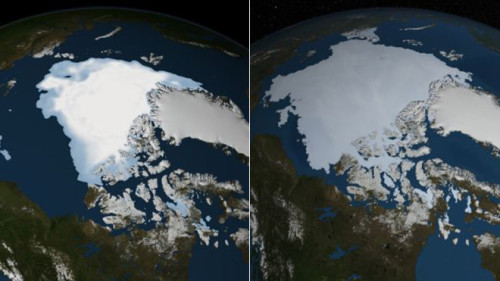Arctic caught a break in 2013, as long-term warming continues


Each year, the National Oceanic and Atmospheric Administration (NOAA) issues the Arctic Report Card, a peer-reviewed update on environmental conditions in the Arctic. The new Arctic Report Card issued this week suggests that, while temperatures were less extreme in 2013 than in 2012 and while less ice melted this past summer than in some summers before, overall the warming trend in the Arctic – as displayed by a variety of indicators – continues. David M. Kennedy, NOAA’s deputy under secretary for operations, said during a press briefing today at the 2013 American Geophysical Union meeting in San Francisco:
The Arctic caught a bit of a break in 2013 from the recent string of record-breaking warmth and ice melt of the last decade. But the relatively cool year in some parts of the Arctic does little to offset the long-term trend of the last 30 years: the Arctic is warming rapidly, becoming greener and experiencing a variety of changes, affecting people, the physical environment, and marine and land ecosystems.
Highlights of the 2013 Arctic Report Card
Summer surface air temperatures were particularly low across the central Arctic Ocean, northern Canada and Greenland relative to 2007-2012 (a period of pronounced summer sea ice retreat), and were somewhat lower than the long-term average of 1981-2010.
Snow extent in May 2013 reached a new record low in Eurasia, while Northern Hemisphere-wide snow extent was below average for spring (April, May, June).
Arctic tundra vegetation greenness (a measure of productivity) and growing season length have continued to increase since observations began in 1982.
Minimum sea ice extent in September 2013 exceeded the record low of 2012, but was the 6th lowest since observations began in 1979 despite the relatively cool summer of 2013. The seven lowest minimum ice extents have occurred in the last seven years, 2007-2013.
Large land mammals convey a mixed message, with muskox numbers stable/increasing since the 1970s, while many caribou and reindeer herds currently have unusually low populations for the period 1970-2013.
Changes in fish and bottom dwelling organisms include continued northward migration of species not previously seen in the Arctic.
Bottom line: The new Arctic Report Card points to cooler temperatures in summer 2013 across the central Arctic Ocean, Greenland and northern Canada. Record sea ice loss occurred in the Arctic – and there was extensive ice melting across the Greenland ice sheet – in 2012, but 2013 summertime ice loss was less. Regional extremes included record low May snow cover in Eurasia and record high summer temperatures in Alaska. Overall, many indicators point to the effects of a persistent warming trend in the Arctic that began over 30 years ago.
More results from this week’s AGU meeting:
Antarctic ozone hole is not yet in recovery
The weird object near Saturn’s A ring
Proposed step to help society prepare for a solar storm disaster











